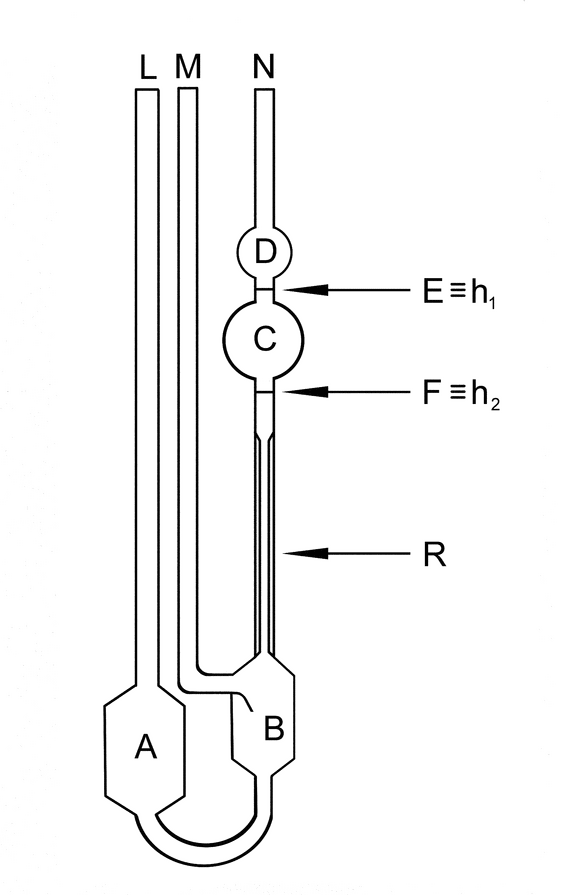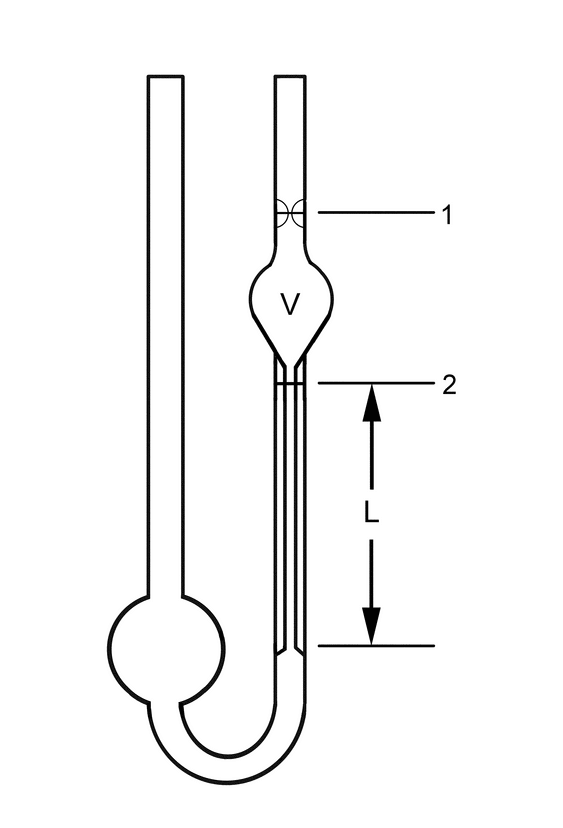Change to read:
Change to read:
Change to read:
• Method I.
Apparatus:
The determination may be carried out with

 USP38
USP38

 USP38
USP38

 USP38
USP38
Procedure:
Fill the viscometer through tube (L) with a sufficient quantity of the sample liquid that is appropriate for the viscometer being used or by following the manufacturer’s instructions. Carry out the experiment with the tube in a vertical position. Fill bulb (A) with the liquid, and also ensure that the level of liquid in bulb (B) is below the exit to the ventilation tube (M). Immerse the viscometer in a water or oil bath stabilized at the temperature specified in the individual monograph, and control the temperature to ±0.1 , unless otherwise specified in the individual monograph. Maintain the viscometer in a vertical position for a time period of NLT 30 min to allow the sample temperature to reach equilibrium. Close tube (M), and raise the level of the liquid in tube (N) to a level about 8 mm above mark (E
, unless otherwise specified in the individual monograph. Maintain the viscometer in a vertical position for a time period of NLT 30 min to allow the sample temperature to reach equilibrium. Close tube (M), and raise the level of the liquid in tube (N) to a level about 8 mm above mark (E  h1). Keep the liquid at this level by closing tube (N) and opening tube (M). Open tube (N), and measure the time required for the level of the liquid to drop from mark (E
h1). Keep the liquid at this level by closing tube (N) and opening tube (M). Open tube (N), and measure the time required for the level of the liquid to drop from mark (E  h1) to mark (F
h1) to mark (F  h2), using an appropriate accurate timing device. [Note—
h2), using an appropriate accurate timing device. [Note—

 USP38
USP38
Calibration:
Calibrate each viscometer at the test temperature by using fluids of known viscosities of appropriate viscosity standards to determine the viscometer constant, k. The viscosity values of the calibration standards should bracket the expected viscosity value of the sample liquid.

 USP38
USP38
Calculate the viscometer constant, k, in mm2/s2:
k =  /(
/( × t)
× t)
| = | = known viscosity of the liquid (mPa·s) | |
| = | = density of the liquid (g/mL) | |
| t | = | = flow time for the liquid to pass from the upper mark to the lower mark (s) |
Calculation of kinematic and Newtonian viscosities of sample fluid:
A capillary viscometer is chosen so that the flow time, t,

 USP38
USP38
 = v ×
= v × 
v = k × t
If the density of the fluid is known at the temperature of the viscosity measurement, then the Newtonian viscosity,  , in mPa·s, is calculated:
, in mPa·s, is calculated:
| = | = density of the fluid (g/mL) |
The flow time of the fluid under examination is the mean of NLT three consecutive determinations. The result is valid if the percentage of the relative standard deviation (%RSD) for the three readings is NMT 2.0%.
Change to read:
• Method II.
Apparatus:
The determination may be carried out with

 USP38
USP38

|
| = | =
|
|
| = | =
|
|
| = | =
|
|
| = | =
|
Other viscometers, such as modified Ostwald-type capillary viscometers,1 may be used provided that the accuracy and precision is NLT that obtained with the viscometers described in this chapter. USP38
USP38
Procedure:
Fill the tube with an amount of the sample that is appropriate for the viscometer being used or by following the manufacturer’s instructions. The volume of fluid used should be such that the lower bulb is not entirely emptied when the fluid is drawn up through the capillary tube to the uppermost graduation mark. Carry out the experiment with the tube in a vertical position. Immerse the viscometer in a water or oil bath stabilized at the temperature specified in the individual monograph, and control the temperature to ±0.1 , unless otherwise specified in the individual monograph. Maintain the viscometer in a vertical position for a time period of NLT 30 min to allow the sample temperature to reach equilibrium. Using suction, draw the fluid up through the capillary tube until the meniscus is at the level of the uppermost graduation. With both the filling and capillary tubes open to atmospheric pressure, record the time, in s, required for the liquid to flow from the upper mark to the lower mark in the capillary tube. [Note—The minimum flow time should be 200 s. ]
, unless otherwise specified in the individual monograph. Maintain the viscometer in a vertical position for a time period of NLT 30 min to allow the sample temperature to reach equilibrium. Using suction, draw the fluid up through the capillary tube until the meniscus is at the level of the uppermost graduation. With both the filling and capillary tubes open to atmospheric pressure, record the time, in s, required for the liquid to flow from the upper mark to the lower mark in the capillary tube. [Note—The minimum flow time should be 200 s. ]
Calibration and Calculation of kinematic and Newtonian viscosities of sample fluid:
Proceed as directed in Method I.

 USP38
USP38
Auxiliary Information—
Please check for your question in the FAQs before contacting USP.
| Topic/Question | Contact | Expert Committee |
|---|---|---|
| General Chapter | Hong Wang, Ph.D.
Senior Scientific Liaison (301) 816-8351 |
(GCPA2010) General Chapters - Physical Analysis |
USP38–NF33 Page 679
Pharmacopeial Forum: Volume No. 39(5)





